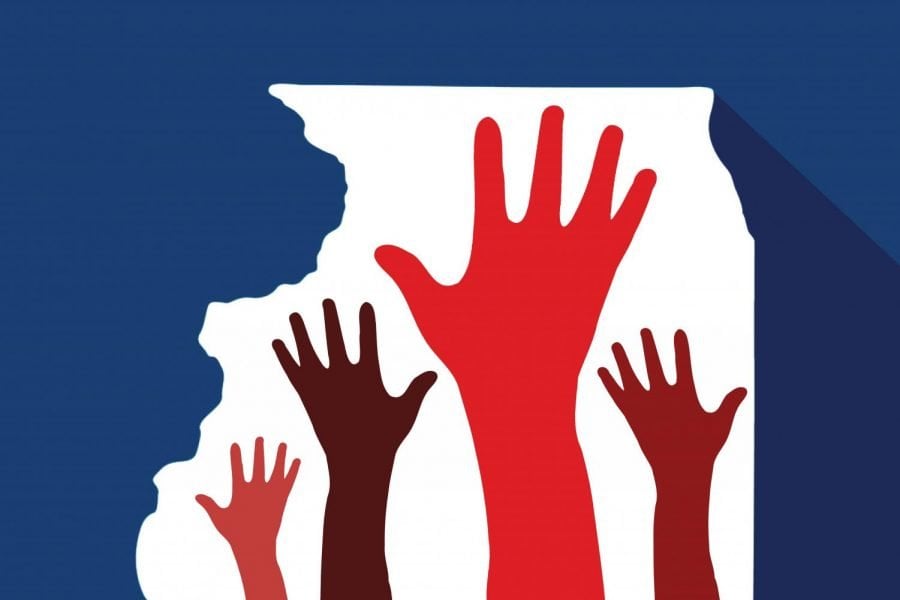Union organizers debate ‘Workers Rights Amendment’ as November vote draws near
Illustration by Catherine Buchaniec
The proposed legislation would prevent “right-to-work” laws in Illinois.
June 16, 2022
With the Illinois Right to Collective Bargaining Measure appearing on the midterm ballot this November, workers have potential for a major win.
Designated “Amendment 1,” the legislation would establish a state constitutional right to collective bargaining, counteracting “right-to-work” laws that prohibit making union membership a condition of employment.
Eric Bailey, the communications director for Service Employees International Union Local 73, which represents the Northwestern University Library Workers Union, said right-to-work laws are about “decimating” unions.
“They recognize that if you take away the members, then you take away the collective power of the unions,” he said.
Although Illinois has not, twenty-seven states have enacted right-to-work laws. Some extend beyond union requirement, such as Kentucky’s 2017 law which states, “No public employee may strike or engage in a work stoppage.”
Josh Honn, a member of NULWU, said Illinois is “surrounded by right-to-work states,” including Indianna and Wisconsin. The amendment would prevent the spread of this legislation to Illinois, Honn said.
“We’re seeing in right-to-work states that most folks are losing wages and losing the ability to support their families and communities,” he said.
SESP junior Neva Legallet is a member of Students Organizing for Labor Rights, which has worked closely with campus unions since 2018.
She said recent union growth nationally has resulted from poor working conditions, especially during the COVID-19 pandemic.
“The labor movement has a lot of momentum right now,” Legallet said. “It’s the product of the fact that wages have been very stagnant for decades now, and yet the cost of living and inflation has grown faster and faster exponentially.”
She said while the movement is growing organically, legislation remains crucial to ensuring lasting change.
Although grassroots organizing will happen regardless, legal protections would decrease barriers to unionization, Northwestern University Graduate Workers outgoing co-Chair and fifth-year Ph.D. candidate Julie Ming Liang said. NUGW has organized around graduate student benefits since 2016, including five-year tuition funding and paid medical leave.
“You don’t really need the law to organize, but it helps to have that legal precedent,” Liang said.
Political science Prof. Daniel Galvin, who specializes in worker’s rights and labor politics, said the unionization process is “littered with obstacles” and “favors the employer at every turn.”
About 90% of workers do not have collective bargaining abilities, Galvin said, preventing employee negotiations.
“Low-wage workers are probably the ones who are most in need of rights and protections,” Galvin said. “They’re the ones who have turned to these small community-based organizations to recreate the kind of substantive rights that you might have otherwise gotten through collective bargaining agreements.”
These non-unionized workers see collective bargaining as the “gold standard,” he added.
According to Legallet, non-unionized workers at the University, like Safe Ride drivers, could benefit from Amendment 1.
The amendment has not avoided controversy, however. In April, two Chicago Public Schools teachers and two parents filed a lawsuit against the Illinois State Board of Elections to remove Amendment 1 from the November ballot. They claimed Amendment 1 conflicts with the National Labor Relations Act. A circuit judge denied the petition on May 26.
Although Amendment 1 applies to both the public and private sectors, private-sector employees are currently protected by the federal National Labor Relations Act. Amendment 1 would impact public-sector workers and provide additional protections to the private sector if the NLRA were appealed.
Bailey said many groups, such as the Illinois Policy Institute, have been spreading misinformation about the amendment, saying it would allow unions to raise taxes on taxpayers.
“I was a lobbyist for five years, wrote and passed a lot of bills. I never saw anything in this amendment that allows us to set the tax rates,” he said.
The amendment’s place on the midterm ballot is contingent on the lawsuit, Bailey said. He added that those unaware of the amendment may be key in the election’s result.
“What often happens with amendments like this is they can go unnoticed right up until the election.” Bailey said. “It will really be a battle of messaging for the voters to explain to them exactly what it is, and what it means.”
Email: [email protected]
Twitter: @annalisepete
Related Stories:












